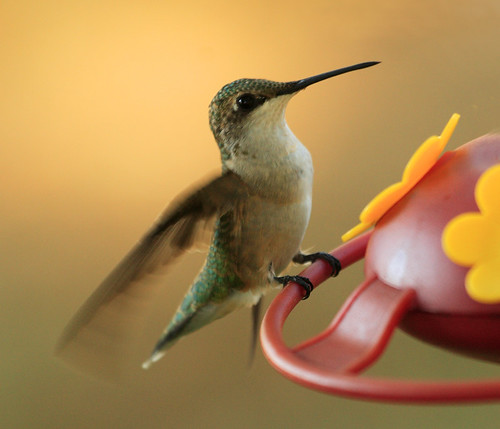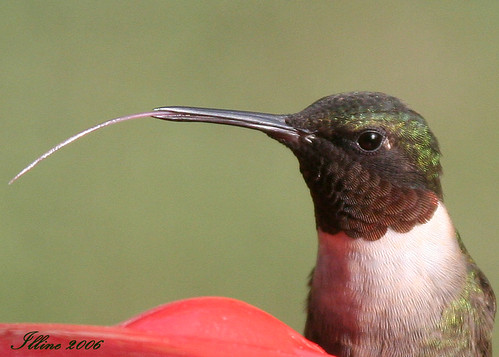Ready for Hummingbirds

by Arthur
Posted on Thursday, April 2nd, 2009 at 10:10 am CET
We’ve been following this Hummingbird Migration Map that shows the migration of Ruby-throated Hummingbirds. The small birds winter between southern Mexico and northern Panama and they start moving north as early as January. They cross the Gulf of Mexico nonstop for up to 500 miles and once in North America they migrate at an average rate of about 20 miles per day. We’ve been following their migration on the map since they entered the United States in late February. Today we saw that they have been reported here in northern Illinois, so we rushed out and set up our Hummingbird feeder:

Hummingbirds can hover in mid-air by rapidly flapping their wings 12–90 times per second. They get the energy they need to maintain their high metabolism from flower nectar and sugar water from feeders. We’ve filled our feeder with 1 part sugar and 4 parts water, which is the magic formula. The red feeder has small holes in the shape of flowers that the hummingbirds drink from.

Of course, there’s no guarantee that we’ll get them here at our new house, but we can at least try.
Here are some nice hummingbird pictures from others. Hopefully we’ll be able to post our own pictures soon.

Photo by redow
Photo by illinesmith
Photo by vtpeacenik
Photo by *~Dawn~*
Photo by Amyn KassamHere’s part of the map that shows that they were reported here this week:

We’ve been following this Hummingbird Migration Map that shows the migration of Ruby-throated Hummingbirds. The small birds winter between southern Mexico and northern Panama and they start moving north as early as January. They cross the Gulf of Mexico nonstop for up to 500 miles and once in North America they migrate at an average rate of about 20 miles per day. We’ve been following their migration on the map since they entered the United States in late February. Today we saw that they have been reported here in northern Illinois, so we rushed out and set up our Hummingbird feeder:

Hummingbirds can hover in mid-air by rapidly flapping their wings 12–90 times per second. They get the energy they need to maintain their high metabolism from flower nectar and sugar water from feeders. We’ve filled our feeder with 1 part sugar and 4 parts water, which is the magic formula. The red feeder has small holes in the shape of flowers that the hummingbirds drink from.

Of course, there’s no guarantee that we’ll get them here at our new house, but we can at least try.
Here are some nice hummingbird pictures from others. Hopefully we’ll be able to post our own pictures soon.

Photo by redow

Photo by illinesmith

Photo by vtpeacenik

Photo by *~Dawn~*

Photo by Amyn Kassam
Here’s part of the map that shows that they were reported here this week:



8:05 am
Hi! Just to let you know that I saw a hummingbird yesterday, Sunday, April 26 at 11:30 a.m. in my backyard feeder. I am in northwest Illinois in rural Orangeville (Stephenson County) — out in the country. One also came back this morning.